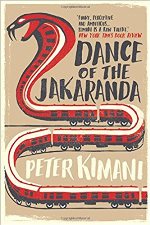Dance of the Jakaranda
In 1901, a train chugs along Kenya’s Rift Valley on the newly laid tracks from Mombasa to Port Victoria. Seated in the first-class cabin, conversing amiably, are Ian McDonald (“Master”), the railway superintendent, and Reverend Turnbull. As the train passes through a township, Master recalls that this was where they’d left their technician Babu, the Indian “f— bastard,” and Turnbull acknowledges that he is now raising that man’s allegedly illegitimate daughter. Master receives land near Lake Nakuru and builds a mansion especially for his wife, but she refuses to reside there. Following its operation as a farm and a hunting lodge, it’s turned into the Jakaranda Hotel. In 1963, Babu’s grandson, Rajan, makes his living singing in the hotel’s dance band. One evening, during a dance at the Jakaranda, a power outage occurs, and a mysterious girl kisses Rajan and disappears. He cannot forget the taste of her lavender-flavored lips and, searching for her, he learns about something from the shadowy past.
 Peter Kimani, an acclaimed writer and poet, has brilliantly constructed this novel’s plot by weaving parallel storylines about McDonald, Turnbull, and Babu, which intersect years later with Rajan’s story. Kenya’s pre- and post-colonial era, interracial relationships, and railroad building provide an appealing backdrop for his chronicle. Kimani’s lyrical prose, such as portraying the train as “a massive snakelike creature,” and his breathtaking descriptions of “God’s country” bring the beauty of the land before our eyes. The literary allusions also help to smooth the racially charged scenes. However, the novel is told mostly in the African storytelling tradition, and some readers might find the narrative excessively descriptive, although the expertly written dialogue and natives’ observations can make the story lively. This is an important novel to come out of Africa, and it does much to assist in our understanding of that region.
Peter Kimani, an acclaimed writer and poet, has brilliantly constructed this novel’s plot by weaving parallel storylines about McDonald, Turnbull, and Babu, which intersect years later with Rajan’s story. Kenya’s pre- and post-colonial era, interracial relationships, and railroad building provide an appealing backdrop for his chronicle. Kimani’s lyrical prose, such as portraying the train as “a massive snakelike creature,” and his breathtaking descriptions of “God’s country” bring the beauty of the land before our eyes. The literary allusions also help to smooth the racially charged scenes. However, the novel is told mostly in the African storytelling tradition, and some readers might find the narrative excessively descriptive, although the expertly written dialogue and natives’ observations can make the story lively. This is an important novel to come out of Africa, and it does much to assist in our understanding of that region.










